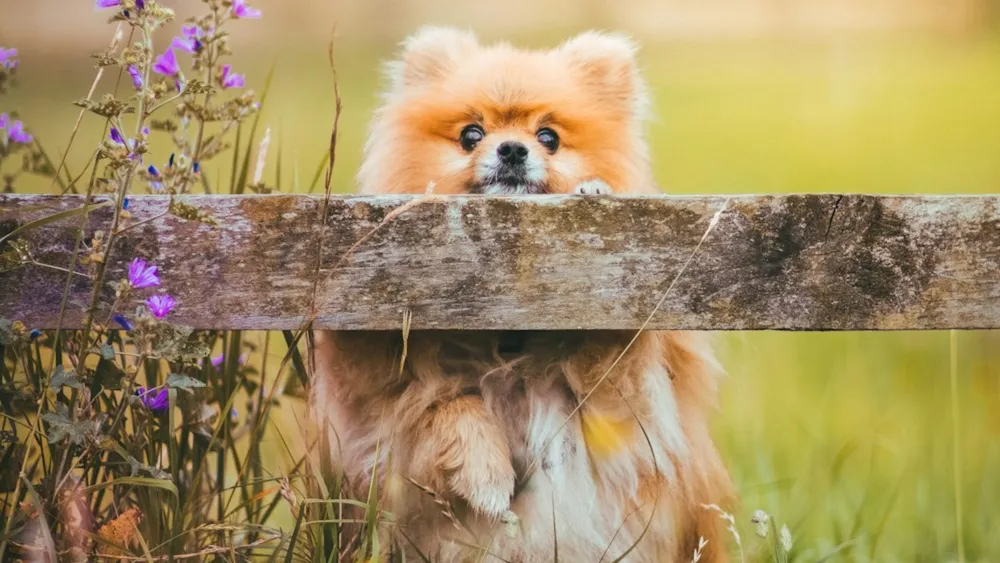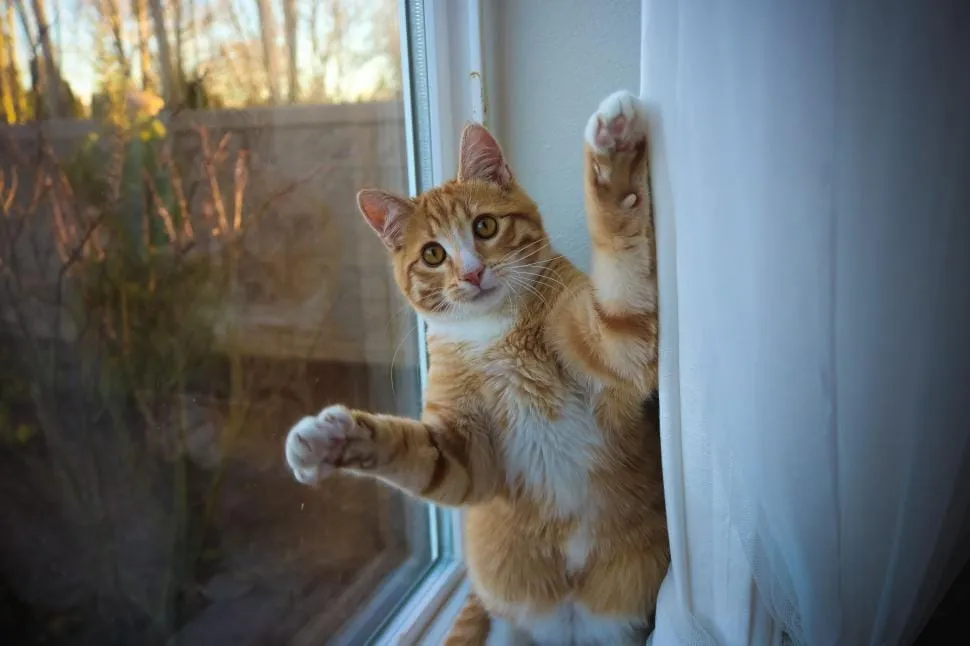Pomeranians are a popular breed of toy dogs known for their playful and affectionate nature. They are also known for their small size and fluffy coat. On the other hand, cats are one of the most common household pets and are known for their independent and curious nature. However, when it comes to introducing a Pomeranian to a household with a cat, many pet owners wonder if the two will get along.

While every dog and cat is unique, Pomeranians are generally good with cats. Pomeranians are friendly and social animals that enjoy being around people and other pets. They are also known for their adaptability, which means that they can adjust to new environments and situations quickly. However, it is important to note that proper introductions and supervision are crucial to ensure that the two pets get along well.
Understanding Pomeranians
Breed Characteristics
Pomeranians are a small breed of dog that originated in Pomerania, a region in Europe. They are popular pets due to their small size, cute appearance, and spunky personality. Pomeranians are known for their fluffy coats, which can come in a variety of colors. They have a short muzzle and pointed ears that stand erect.
Pomeranians are intelligent and affectionate dogs, but they can also be stubborn and independent. They have a strong hunting instinct and may chase after small animals, including cats. However, with proper socialization and training, Pomeranians can learn to coexist peacefully with cats.

Energy Levels and Exercise Needs
Pomeranians are active dogs that require daily exercise. They have a moderate energy level and enjoy going for walks, playing fetch, and participating in other activities. However, due to their small size, they do not require as much exercise as larger dogs.
Socialization and Training
Socialization and training are crucial for Pomeranians to learn how to behave around cats and other animals. Pomeranians are intelligent and can learn quickly, but they may also be stubborn and difficult to train at times. Positive reinforcement techniques, such as treats and praise, are effective in training Pomeranians.
Pomeranians are affectionate and loyal dogs that make great pets for the right owner. With proper socialization and training, they can coexist peacefully with cats and other animals. However, it is important to keep in mind their strong hunting instincts and supervise them around small animals.

Understanding Cats
Cats are fascinating creatures that have been domesticated for thousands of years. They are known for their independent and outgoing personalities, as well as their unique communication and body language. Understanding cats is essential for anyone who wants to keep them as pets, especially if they have other animals in the house.
Feline Personalities
Cats have different personalities, just like humans. Some cats are friendly and outgoing, while others are more reserved and independent. It is important to understand your cat's personality so that you can provide them with the appropriate care and attention they need. For example, if you have a shy cat, you may need to give them more space and time to adjust to new environments or people.
Communication and Body Language
Cats communicate with each other and humans through a variety of methods, including vocalizations, body language, and scent marking. Understanding cat language can help you identify when your cat is happy, scared, or agitated. For example, a cat that is purring is usually content and relaxed, while a cat that is hissing or growling is likely feeling threatened or defensive.
Cats also use their body language to communicate. For example, a cat that is arching its back and puffing up its fur is likely feeling scared or threatened. On the other hand, a cat that is rubbing its head against you is showing affection and marking you with its scent.
Territorial Behavior
Cats are territorial animals and may become aggressive if they feel their space is being invaded. It is important to provide your cat with a safe and secure environment where they can feel comfortable and relaxed. If you have other animals in the house, it is important to introduce them slowly and supervise their interactions to prevent any aggression or fighting.
In conclusion, understanding cats and their unique personalities, communication, and territorial behavior is essential for anyone who wants to keep them as pets. By providing them with the appropriate care and attention they need, you can ensure that your cat is happy, healthy, and well-adjusted.

Creating a Harmonious Household
Pets are a great addition to any household, but introducing a new pet can be a challenge, especially when it comes to introducing a Pomeranian to a cat. However, with proper preparation and management, Pomeranians and cats can live together in peace and harmony.
Introducing Pomeranians to Cats
The first step in introducing a Pomeranian to a cat is to supervise their interactions. It is essential to introduce them slowly and in a controlled environment. Keep the Pomeranian on a leash and let the cat approach on its own terms. If either pet shows signs of aggression, separate them immediately and try again later.
Maintaining Peace and Preventing Conflicts
To maintain a peaceful coexistence between Pomeranians and cats, it is essential to provide separate spaces for each pet. Each pet has different needs, and it is crucial to ensure that they have their own space to retreat to. Providing separate spaces will also help prevent conflicts and reduce stress.
Separate Spaces and Sleeping Arrangements
Pomeranians and cats have different sleeping habits and requirements. It is essential to provide separate sleeping arrangements for each pet. Pomeranians prefer to sleep in a cozy, warm bed, while cats prefer to sleep in a high place, such as a cat tree. Providing separate sleeping arrangements will help prevent conflicts and ensure that each pet gets the rest they need.
In conclusion, introducing a Pomeranian to a cat requires patience, supervision, and preparation. By providing separate spaces, supervising interactions, and maintaining peace, Pomeranians and cats can live together in a harmonious household.

Behavioral Considerations
Pomeranians are generally good with cats, but it is important to consider their behavioral tendencies and instincts when introducing them to a feline companion. By understanding and managing these behaviors, owners can ensure a positive and safe relationship between their Pomeranian and cat.
Recognizing Stress and Aggression
It is important to recognize signs of stress and aggression in both the Pomeranian and the cat. Stress can manifest in various ways such as excessive barking, panting, or pacing. Aggressive behavior can include growling, biting, or scratching. If either animal is exhibiting these behaviors, it is important to separate them and seek advice from a behaviorist or animal behaviorist.
Managing Playful and Predatory Instincts
Pomeranians have a playful nature and may exhibit predatory instincts towards a cat. It is important to supervise interactions between the two animals and redirect any playful or predatory behavior towards toys or other objects. Positive reinforcement in the form of treats and praise can also encourage desirable behavior.
Encouraging Positive Interactions
Building a positive relationship between a Pomeranian and cat requires patience and consistent training. Owners should encourage curiosity and reward good behavior with treats and praise. Gradually increasing the amount of time the animals spend together can also help to build a positive relationship.
In summary, introducing a Pomeranian to a cat requires careful consideration and management of their behaviors and instincts. By providing proper training, supervision, and positive reinforcement, owners can foster a safe and harmonious relationship between their furry companions.
Practical Tips for Pet Owners

Choosing the Right Toys and Activities
When it comes to Pomeranians and cats, it's important to choose toys and activities that are safe for both pets. Avoid toys that are too small and could be swallowed by either pet. Interactive toys, such as puzzle feeders, can be a great way to keep both pets entertained and mentally stimulated. Make sure to supervise playtime and separate the pets if any aggression occurs.
Feeding and Grooming Considerations
Pomeranians and cats have different nutritional needs, so it's important to feed them separately. Keep their food bowls in separate areas to prevent any food aggression. When it comes to grooming, Pomeranians require regular brushing and grooming to keep their coats healthy and free of mats. Cats also benefit from regular grooming to prevent hairballs and other issues. Make sure to use separate grooming tools for each pet to prevent the spread of any potential diseases.
When to Seek Professional Help
If you notice any signs of aggression between your Pomeranian and cat, it's important to seek professional help. A veterinarian or animal behaviorist can provide guidance on how to manage the situation and prevent any further issues. Additionally, if either pet shows any signs of illness or injury, it's important to seek veterinary care immediately.
Helpful Tips:
- Introduce your Pomeranian and cat slowly and gradually, allowing them to get used to each other's scents and presence before allowing direct interaction.
- Provide separate sleeping areas for both pets to prevent any territorial issues.
- Keep your Pomeranian on a leash when introducing them to a cat to prevent any chasing or aggressive behavior.
Conclusion
In conclusion, Pomeranians can be good with cats, but it ultimately depends on their individual personalities and the way they are introduced to each other. While there are benefits to having a Pomeranian and a cat coexist peacefully, there are also disadvantages to consider.
One of the benefits of having a Pomeranian and a cat together is that they can become furry friends and provide each other with companionship. However, it's important to note that not all Pomeranians are going to get along with cats. Some may have a high prey drive and see the cat as something to chase or attack.

To help ensure a peaceful coexistence between a Pomeranian and a cat, it's important to introduce them slowly and carefully. This can involve keeping them separated at first and gradually allowing them to spend more time together under supervision.
Overall, the key to having a Pomeranian and a cat coexist peacefully is to be patient and observant. By following helpful tips and being aware of the potential challenges, pet owners can create a happy and harmonious household for all of their furry friends.
FAQs
- Are Pomeranians generally good with cats?
- Yes, Pomeranians are usually friendly and adaptable, making them generally good with cats. However, individual personalities vary, and proper introductions are crucial.
- Do Pomeranians have a strong hunting instinct?
- Yes, Pomeranians have a strong hunting instinct and may chase small animals, including cats. Proper socialization and training are important to manage this behavior.
- How much exercise do Pomeranians require?
- Pomeranians are active dogs with moderate energy levels and need daily exercise, but their small size means they don’t require as much exercise as larger breeds.
- What is the best way to train a Pomeranian to be around cats?
- Positive reinforcement techniques, such as treats and praise, are effective. Consistent training and socialization help Pomeranians learn to behave around cats and other animals.
- How do cats communicate their feelings?
- Cats communicate through vocalizations, body language, and scent marking. Understanding these cues is key to identifying their emotions like happiness, fear, or agitation.
- How should I introduce a Pomeranian to a cat?
- Introduce them slowly in a controlled environment, with the Pomeranian on a leash. Let the cat approach on its own terms and watch for signs of aggression.
- How can I prevent conflicts between my Pomeranian and cat?
- Provide separate spaces for each pet, supervise their interactions, and ensure they have their own sleeping arrangements to reduce stress and prevent conflicts.
- What are signs of stress or aggression in Pomeranians and cats?
- Signs include excessive barking, panting, pacing, growling, biting, or scratching. It's important to separate the pets if these behaviors are observed.
- What toys are safe for both Pomeranians and cats?
- Choose toys that are not too small to be swallowed. Interactive toys like puzzle feeders are good options. Always supervise playtime to prevent aggression.
- Should Pomeranians and cats be fed and groomed differently?
- Yes, they have different nutritional needs, so feed them separately. Use separate grooming tools for each pet to prevent the spread of diseases.
- When should I seek professional help for my Pomeranian and cat?
- Seek help if you notice signs of aggression, or if either pet shows signs of illness or injury. A veterinarian or animal behaviorist can offer guidance.
- What are the benefits and challenges of having a Pomeranian and a cat?
- Benefits include companionship for both pets, but challenges arise if the Pomeranian has a high prey drive. Careful, supervised introductions are key.




